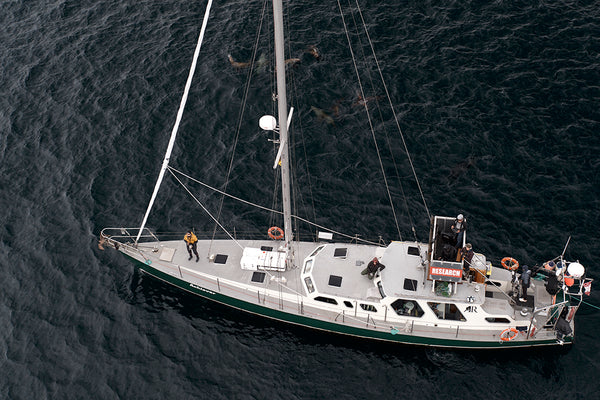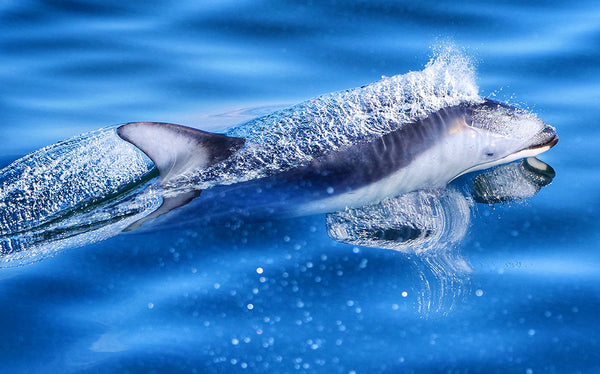As a strong supporter of Raincoast Conservation Foundation through our 1% for the Planet partnership, we are passionate about supporting initiatives that blend photography with conservation efforts. In this special interview, we sit down with Dr. Valeria Vergara, a cetacean researcher dedicated to understanding and protecting killer whales through innovative photography techniques. We discuss Dr. Vergara's professional background, her research methodologies, and the critical insights gained through her groundbreaking work.
Cotton Carrier: Where do you call home?
Dr Valeria Vergara: My home is Pender Island (Southern Gulf Islands), situated within W̱SÁNEĆ territory.
CC: How long have you taken photographs for?
VV: I have been taking photographs with a diverse range of cameras for about 35 years. However, the 2023 field season was my first summer participating in this particular killer whale photogrammetry project – a project that has been running for a decade now.

CC: How do you use the photos in your research?
VV: We conduct our fieldwork aboard Raincoast’s research vessel SV Achiever. Our photogrammetry research aims to understand the body condition, and pregnancy and miscarriage rates of individual killer whales. Using a minimally invasive drone at a fixed height of 30m, we take aerial photographs of the whales and we conduct the photogrammetric measurements after our field season. By analyzing pixels from the aerial images, we estimate the whales’ body condition relative to previous years to assess their nutritional status and potential pregnancy. Additionally, aerial views of the whales enable us to capture video of rarely documented behaviors. For identification purposes, we also capture lateral photographs of the whales. This is crucial as it allows us to identify individual whales, a practice made possible by over thirty years of orca photo-identification studies in the Pacific Northwest. These studies, pioneered by Michael Bigg and colleagues, have enabled us to recognize nearly every individual killer whale along the Pacific coast, by the shape of their dorsal fins and saddle patches.

CC: What are some of the changes this research has made? What do you hope it will bring in the future?
VV: This photogrammetry-based research is making it possible to refine our understanding of the relationship between killer whale health and Chinook salmon abundance (their preferred prey). Southern Resident killer whales are endangered and do not seem to be recovering, so expanding our scientific understanding of these whales is crucial to inform policy changes. Prey availability is amongst the three main threats to their recovery, in addition to underwater noise and pollution.

In this study, we work with Northern Resident killer whales as a stand-in for their Southern Resident counterparts. The Northern Residents have many more reproductive age females than the Southern Residents, which helps us sort out other variables that may affect our findings, such as age, gender, and the size of the matrilines.
The project will provide responsible agencies both in the US and Canada with the first standardized system for determining if and when in-season Chinook salmon harvest needs to be adjusted to ensure that killer whales can meet their food requirements.
CC: What Camera(s) / Lenses do you use while doing this research?
Our main camera for the photo-identification work is a Nikon D500 with a Nikkor 80-400mm f/4.5-5.6G ED VR (vibration reduction) lens. We also use a Panasonic Lumix DC-G9 with a Leica DG 50-200mm f/2.8-4.0 OIS Zoom lens, and a Canon 5D Mark 4.
The aerial images for the photogrammetry measurements are obtained with a DJI Inspire 3 drone with some modifications - including handles - that make it safe to take off and land on a moving vessel.

CC: Can you share a favorite experience while doing this research?
VV: Singling out one memorable moment from our immersive killer whale research is a challenging task, a testament to the profound richness of our experiences. Spending days and weeks aboard our research sailboat, observing killer whales and all the creatures that intersect their lives (and ours!) - from playful dolphins and porpoises to graceful sea otters, humpback whales, sea lions, salmon, and sea birds - we find ourselves falling in sync with the rhythms of the whales and these wild habitats. Every moment is a treasure, but if compelled to select, I think that one stands out: that memorable morning of July 26, 2023, when we stumbled upon killer whales using a kelp forest as a spa. Hovering above the A25s, the A54s, and the A73s matrilines with our drone, we witnessed a mesmerizing spectacle. As the whales reached the kelp forest, they immediately abandoned their travel mode and began interacting with the swaying kelp, rubbing against it, spy-hopping with exuberance and spinning in place while using their pectoral flippers to wrap their large bodies with the kelp. It really looked like they were enjoying the tactile sensations of the kelp on their skin. And it wasn't just the kelp they seemed to relish; their interactions with each other were equally delightful to witness. Such social beings, gracefully in tune with their environment and with one another! What must it be like to be them, I wonder, to inhabit their world, to navigate it with such effortless fluidity and harmony, so attuned to the nuances of touch and interconnectedness?

About Raincoast Conservation Foundation
Raincoast’s Cetacean Conservation program studies the biology, ecology, and behavior of whales, dolphins, and porpoises. Each year, researchers undergo their photogrammetry project which involves capturing aerial photos of individually identified resident killer whales with small, minimally invasive drones to accurately measure the whales’ body condition and growth rates, and to determine whether they are pregnant. The measurements, compared with data available since 2014, provide a direct indication of the whales’ nutritional status, and allow scientists to draw reliable inferences about their overall health. The value of this research is that it allows us to assess the impact of salmon abundance–which is strongly influenced by human fisheries–on the whale’s reproduction and survival





